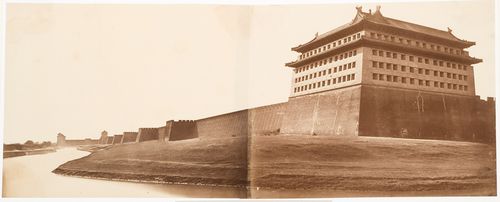photographs
PH1984:1203:012
Description:
- The imprinted label was possibly included after the album was assembled.
architecture
1887 or before
View of T'ien-ning Ssu (now Tianningsi) Pagoda, Peking (now Beijing), China
Actions:
PH1984:1203:012
Description:
- The imprinted label was possibly included after the album was assembled.
photographs
1887 or before
architecture
drawings
PH1979:0603.04:014
architecture, landscape architecture
published 1874
View of a courtyard with a bridge in a mandarin's house, Peking (now Beijing), China
Actions:
PH1979:0603.04:014
drawings
published 1874
architecture, landscape architecture
drawings
PH1979:0603.04:013
architecture, interior design
published 1874
Interior view of a reception room in a mandarin's house, Peking (now Beijing), China
Actions:
PH1979:0603.04:013
drawings
published 1874
architecture, interior design
drawings
PH1979:0603.04:024
architecture
published 1874
View of the principal façade of a shop selling fabric, Peking (now Beijing), China
Actions:
PH1979:0603.04:024
drawings
published 1874
architecture
drawings
Portrait of a peddler selling porcelain, containers and curio boxes, Peking (now Beijing), China
PH1979:0603.04:028
architecture, portrait
published 1874
Portrait of a peddler selling porcelain, containers and curio boxes, Peking (now Beijing), China
Actions:
PH1979:0603.04:028
drawings
published 1874
architecture, portrait
drawings
PH1979:0603.04:022
architecture
published 1874
View of the principal façade of the Bell Tower [Zhong Lou], Peking (now Beijing), China
Actions:
PH1979:0603.04:022
drawings
published 1874
architecture
drawings
PH1979:0603.04:023
architecture
published 1874
View of the principal façade of the Drum Tower [Gu Lou], Peking (now Beijing), China
Actions:
PH1979:0603.04:023
drawings
published 1874
architecture
drawings
View of the altar to Confucius, Temple of Confucius [Kong Miao] [?], Peking (now Beijing), China
PH1979:0603.04:036
architecture, interior design
published 1874
View of the altar to Confucius, Temple of Confucius [Kong Miao] [?], Peking (now Beijing), China
Actions:
PH1979:0603.04:036
drawings
published 1874
architecture, interior design
View of the northeast corner watchtower and walls of the Inner City, Peking (now Beijing), China
PH1979:0482:002
architecture, military
between 13 October and 24 October 1860
View of the northeast corner watchtower and walls of the Inner City, Peking (now Beijing), China
Actions:
PH1979:0482:002
architecture, military
photographs
PH1986:0901:028:001
architecture, military
between 13 October and 24 October 1860
View of the east wall and Dongzhi Gate of the Inner City, Peking (now Beijing), China
Actions:
PH1986:0901:028:001
photographs
between 13 October and 24 October 1860
architecture, military
